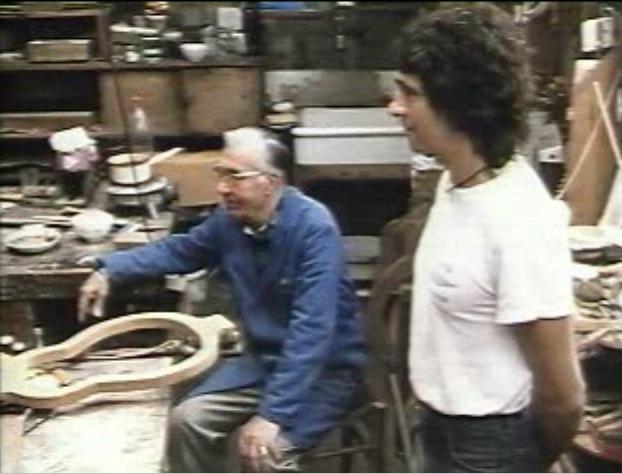|
Favino - a name with sound for all friends of the Swing Tsigane. |
|||
|
|||
|
|||
|
You have an Italian name. Is there already a longer tradition of instrument making in your family? |
|||
| My father and my mother are born in Italy, however they came already as small children to France. Only my father started the tradition. Before there was no instrument maker in my family. Before he came to build a guitar he had various jobs, for example also as a carpenter. During the war he was working for 2 years obligation workers in arms operation in Germany. After the war he worked for a short time as a turner in France. | |||
|
One of his brothers was working at an instrument maker named Busato. My father also entered there. He made banjo necks. With him also was an other violin maker working, Jean Chauvet. Chauvet proposed to my father to learn him to build violins because he saw that he did his thing good. After work Chauvet instructed at his house my father how to build violins. They opened a violin construction industry together in 1946. In an old chicken house, in an Paris suburb, they began to build violins and basses . In the beginning of the fifties they moved into the Rue de Clignancourt. There they operated together for then years, then they divorced themselves. When they formed the business into the 40's, my father already soon became interested in building of guitars. Chauvet remained with violins and basses. |
|||
|
When did your father start to copy the famous Selmer guitars? |
|||
| In the 50's, bout 1954, '55. He already built Archtops before. | |||
|
Your father did not simply build a copy of the Selmer. |
|||
| No! He has always refused to copy Selmer totally. He wanted to build a guitar with personal tone, for personal sound. A " Favino " evenly. That is also my job. Naturally it also depends on the customer - he is king. As a guitar maker one has sufficient experience on the sound used to take. The personal contact to the customer is very important, in order to build the correct guitar for him. My father always said tome" the musician customers teaches you how to build a guitar". Without musicians we cannot build, without an instrument the musician can not play. | |||
|
You are not in Paris anymore, but live and build here in Castelbiague, in the Pyrenees. |
|||
|
As a child I always spend the holidays on the country side- I love the land life. The animals, air, the sun. Here I feel absolute connected with life. But 3 days in the month I am to find in of Paris - always at the end of the month. |
|||
|
Which of your models do you build at most? |
|||
| The Selmer copy! In the 70's mostly Folkmodels. My father, by the way, built the first 12-string guitars in France. His first was for Hugues Auffray, a chansonier. | |||
|
You equip your model Jazz only with " Argentine" strings. Why? |
|||
| They are the correct strings for this guitar. They already were on the original Selmer. Selmer had asked Savarez (string firm) at that time to manufacture strings for their guitar. If someone would like to play stronger strings, he must say it to me, then I have to make the top accordingly thicker. Otherwise the top will sink and the guitar loses tone. | |||
|
How are your guitars best maintained? |
|||
| I believe that it is necessary that each guitarist owes a hygrometer . The air humidity should be between 50% and 60%. The instrument should never be put near a heat source or into a hot car. Also humidity harms. Generally one can say: " where humans feel well, the guitar also feels well'. You should not leave the guitar in the suitcase, the instrument needs air, the wood wants to breathe. Industrial guitars react differently to such effects , because the woods are not naturally dried. For the tone of the guitar it is very important that it is played frequently. Against dryness you can put a sponge in a perforated plastic bag and store it into the string container . Against humidity the same with rice in the plastic bag. It absorbs the humidity. Most important: Leave repairs only to an specialist! | |||
|
|
|||
|
|


